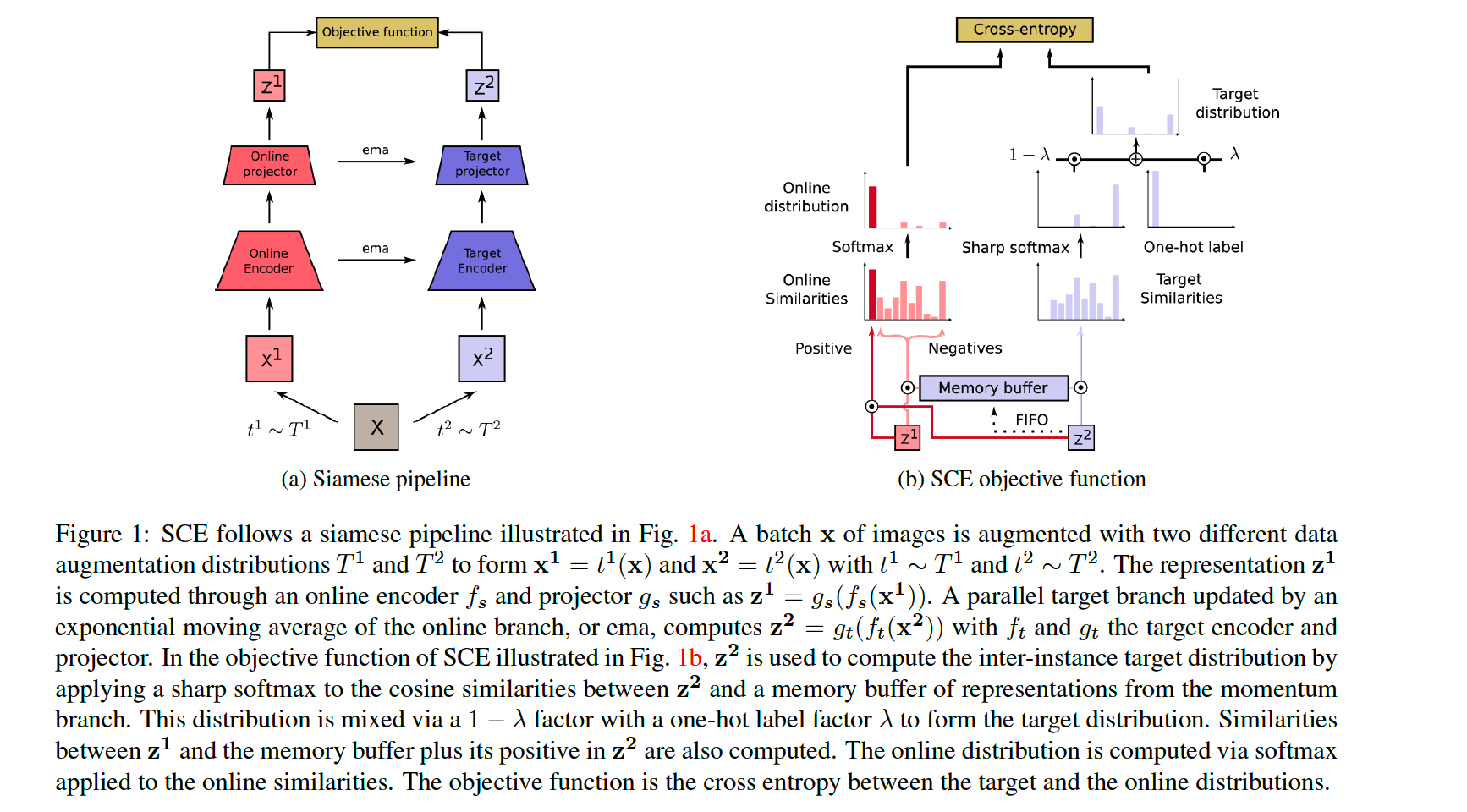Similarity Contrastive Estimation for Self-Supervised Soft Contrastive Learning
Contents
- Abstract
-
Introduction
- Methodology
- Contrastive & Relational Learning
- SCE (Similarity Contrastive Estimation)
0. Abstract
Contrastive Learning :
- mostly based on NCE (Noise Contrastive EStimation)
- other instances = negatives
- Problem : some negatives are drawn from SAME distn
Good data representation
- should contain relations ( semantic similarity ) btw instances
Propose SCE (Similarity Contrastive Estimation)
- a novel formulation of contrastive learning using semantic similarity between instances
- objective function : SOFT contrastive learning
- estimate from one view of a batch a continuous distribution
- this target similarity distribution is sharpened to eliminate noisy relations
1. Introduction
Frameworks based on CL
-
large number of negatives is essential
\(\rightarrow\) Sampling hard negatives improve the representations,
but can be harmful if they are semantically false negatives
= ”class collision problem”
Other approaches : learn ONLY from POSITIVE views
- ex) by predicting pseudo-classes of different views
- ex) minimizing the feature distance of positives
- ex) matching the similarity distribution between views and other instances
Based on the weakness of contrastive learning using negatives …
\(\rightarrow\) introduce a self-supervised soft contrastive learning approach, Similarity Contrastive Estimation (SCE)
- contrasts positive pairs with other instances
-
leverages the push of negatives using the inter-instance similarities
- computes relations defined as a ”sharpened” similarity distribution between augmented views of a batch
2. Methodology
introduce baselines :
-
(for contrastive learning) MoCov2
-
(for relational aspect) ReSSL
propose SCE (Similarity Contrastive Estimation)
(1) Contrastive & Relational Learning
Notation
- \(\mathbf{x}=\left\{\mathbf{x}_{\mathbf{k}}\right\}_{k \in\{1, \ldots, N\}}\) : a batch of \(N\) images
- produce two views of \(\mathrm{x}\)
- \(\mathrm{x}^1=t^1(\mathrm{x})\) and \(\mathrm{x}^2=\) \(t^2(\mathbf{x})\),
- from 2 distn \(T^1\) and \(T^2\) ( with \(t^1 \sim T^1\) and \(t^2 \sim T^2\) )
- \(T^2\) : weak data augmentation distn ( to maintain relations )
- \(\mathrm{x}^1=t^1(\mathrm{x})\) and \(\mathrm{x}^2=\) \(t^2(\mathbf{x})\),
- model architecture
- online network \(f_s\)
- projector \(g_s\)
- two embeddings ( both are \(l_2\)-normalized. )
- \(\mathbf{z}^{\mathbf{1}}=g_s\left(f_s\left(\mathbf{x}^{\mathbf{1}}\right)\right)\).
- \(\mathbf{z}^{\mathbf{2}}=g_t\left(f_t\left(\mathbf{x}^{\mathbf{2}}\right)\right)\). ( model : EMA of online branch )
InfoNCE loss
\(L_{\text {InfoNCE }}=-\frac{1}{N} \sum_{i=1}^N \log \left(\frac{\exp \left(\mathbf{z}_{\mathbf{i}}^1 \cdot \mathbf{z}_{\mathbf{i}}^2 / \tau\right)}{\sum_{j=1}^N \exp \left(\mathbf{z}_{\mathbf{i}}^1 \cdot \mathbf{z}_{\mathbf{j}}^2 / \tau\right)}\right)\).
- a similarity based function
- scaled by the temperature \(\tau\)
ReSSL
target similarity distribution \(\mathbf{s}^{\mathbf{2}}\),
- represents the relations between weak augmented instances
- temperature parameters : \(\tau_m\)
similarity distribution \(\mathbf{s}^{\mathbf{1}}\)
- represents the relations between strong & weak augmented instances
- temperature parameters : \(\tau\) ( where \(\tau>\tau_m\) to eliminate noisy relations )
Loss function :
CE between \(s^2\) and \(s^1\) :
\(\begin{gathered} s_{i k}^1=\frac{\mathbb{1}_{i \neq k} \cdot \exp \left(\mathbf{z}_{\mathbf{i}}^1 \cdot \mathbf{z}_{\mathbf{k}}^2 / \tau\right)}{\sum_{j=1}^N \mathbb{1}_{i \neq j} \cdot \exp \left(\mathbf{z}_{\mathbf{i}}^1 \cdot \mathbf{z}_{\mathbf{j}}^2 / \tau\right)}, \\ s_{i k}^2=\frac{\mathbb{1}_{i \neq k} \cdot \exp \left(\mathbf{z}_{\mathbf{i}}^2 \cdot \mathbf{z}_{\mathbf{k}}^2 / \tau_m\right)}{\sum_{j=1}^N \mathbb{1}_{i \neq j} \cdot \exp \left(\mathbf{z}_{\mathbf{i}}^2 \cdot \mathbf{z}_{\mathbf{j}}^2 / \tau_m\right)}, \\ L_{R e S S L}=-\frac{1}{N} \sum_{i=1}^N \sum_{\substack{k=1 \\ k \neq i}}^N s_{i k}^2 \log \left(s_{i k}^1\right) . \end{gathered}\).
Memory buffer ( size : M » N )
- filled by \(\mathbf{z}^{\mathbf{2}}\)
<br.
(2) SCE (Similarity Contrastive Estimation)
Contrastive Learning
- damage relations among instances which Relational Learning correctly build.
Relational Learning
- lacks the discriminating features that contrastive methods can learn

Similarity Contrastive Estimation (SCE)
We argue that there exists a true distribution of similarity \(\mathbf{w}_{\mathbf{i}}^*\)
- between a query \(\mathbf{q}_{\mathbf{i}}\) and \(\mathbf{x}=\left\{\mathbf{x}_{\mathbf{k}}\right\}_{k \in\{1, \ldots, N\}}\)
- \(\mathbf{x}_{\mathbf{i}}\) : a positive view of \(\mathbf{q}_{\mathbf{i}}\)
Training framework
-
estimate the similarity distribution \(\mathbf{p}_{\mathbf{i}}\)
- between \(\mathbf{q}_{\mathbf{i}}\) and all instances in \(\mathrm{x}\)
-
minimize the CE between \(\mathrm{w}_{\mathbf{i}}^*\) and \(\mathbf{p}_{\mathbf{i}}\)
= soft contrastive learning objective
Loss Function of SCE
- \(L_{S C E^*}=-\frac{1}{N} \sum_{i=1}^N \sum_{k=1}^N w_{i k}^* \log \left(p_{i k}\right)\).
-
SOFT contrastive approach that generalizes InfoNCE and ReSSL objectives
- InfoNCE ( = HARD contrastive loss )
- estimates a hard contrastive loss that estimates \(\mathrm{w}_{\mathbf{i}}^*\) with a one-hot label
- ReSSL :
- estimates \(\mathbf{w}_{\mathbf{i}}^*\) without the contrastive component.
This paper : propose an estimation of \(\mathbf{w}_{\mathbf{i}}^*\)
-
based on both (1) contrastive and (2) relational learning
-
Procedures
-
step 1) \(\mathrm{x}^1=t^1(\mathrm{x})\) & \(\mathrm{x}^2=\) \(t^2(\mathbf{x})\)
-
step 2) \(\mathbf{z}^{\mathbf{1}}=g_s\left(f_s\left(\mathbf{x}^{\mathbf{1}}\right)\right)\) & \(\mathbf{z}^2=g_t\left(f_t\left(\mathbf{x}^2\right)\right) \cdot \mathbf{z}^1\)
- both are \(l_2\)-normalized
-
step 3) similarity distribution \(\mathbf{s}^2\)
- \(s_{i k}^2=\frac{\mathbb{1}_{i \neq k} \cdot \exp \left(\mathbf{z}_{\mathbf{i}}^2 \cdot \mathbf{z}_{\mathbf{k}}^2 / \tau_m\right)}{\sum_{j=1}^N \mathbb{1}_{i \neq j} \cdot \exp \left(\mathbf{z}_{\mathbf{i}}^2 \cdot \mathbf{z}_{\mathbf{j}}^2 / \tau_m\right)}\).
-
step 4) build target distn \(\mathbf{w_i}^2\)
-
weighted positive one-hot label is added to \(\mathbf{s_i}^2\)
-
\(w_{i k}^2=\lambda \cdot \mathbb{1}_{i=k}+(1-\lambda) \cdot s_{i k}^2\).
-
- step 5) compute online similarity distn \(\mathbf{p}_{\mathrm{i}}^1\)
- between \(\mathbf{z}_{\mathrm{i}}^1\) & \(\mathbf{z}^2\)
- \(p_{i k}^1=\frac{\exp \left(\mathbf{z}_{\mathbf{i}}^1 \cdot \mathbf{z}_{\mathbf{k}}^2 / \tau\right)}{\sum_{j=1}^N \exp \left(\mathbf{z}_{\mathbf{i}}^1 \cdot \mathbf{z}_{\mathbf{j}}^2 / \tau\right)}\).
- step 6) objective function : CE loss btw \(\mathbf{w}^2\) & \(\mathbf{p}^1\)
- \(L_{S C E}=-\frac{1}{N} \sum_{i=1}^N \sum_{k=1}^N w_{i k}^2 \log \left(p_{i k}^1\right)\).
-
-
Memory Buffer :
- size : \(M >>N\)
- filled by \(\mathbf{z}^2\)

